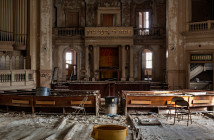Architecture critic Ada Louise Huxtable, the first-ever to win in 1970 the Pulitzer Prize for distinguished criticism, has died at 91.
Through her passionate and articulate writings, Ms. Huxtable paved the way for many of us writing about architecture, and is often credited for establishing the profession of architectural criticism as we know it today.
A fierce champion of historic preservation and cities, Ms. Huxtable served as architecture critic for the New York Times from 1963 to 1982, penning on Oct. 30, 1963 powerful words that are now synonymous with the current preservation movement: "Any city gets what it admires, will pay for, and, ultimately deserves. Even when we had Penn Station, we couldn’t afford to keep it clean. We want and deserve tin-can architecture in a tin-horn culture. And we will probably be judged not by the monuments we build but by those we have destroyed."
A 1981 winner of the MacArthur Fellowship and also a Fulbright scholar, Ms. Huxtable served as architecture critic for the Wall Street Journal since 1997.
As an aspiring architecture critic, Ms. Huxtable embodied everything I wish to be in a writer. Her honest and at times humorous reviews taught me how to look at the world differently, how to look at buildings and cities and listen to the richly-layered stories they all tell.
Ms. Huxtable wrote about much of the architecture being built in New England during her long profession as a critic, including Boston City Hall. She considered what is arguably the most hated building in the city "…a structure of dignity, humanism, and power. It mixes strength with subtleties. It will outlast the last hurrah," she wrote in her February 4, 1969 New York Times review of the building.
Ms. Huxtable was architecture’s most prolific critic. In her last piece for the Wall Street Journal, she reminded us of the need to preserve and update architecturally significant buildings: "Buildings change; they adapt to needs, times and tastes. Old buildings are restored, upgraded and converted to new uses. For architecturally significant buildings with landmark protection, the process is more complex; subtle, subjective and difficult decisions are often required. Nothing, not even buildings, stand still,"she wrote, "[t]he results will be spectacular, and probably no more costly than the extravagant and destructive plan the library has chosen." "Do New Yorkers love their library any less?"she added.
Ms. Huxtable's legacy will live on forever and continue to inspire the current and future generation of architecture critics.
- Photo: Harry Heleotis
Thumbnail Photo: John Goodman






